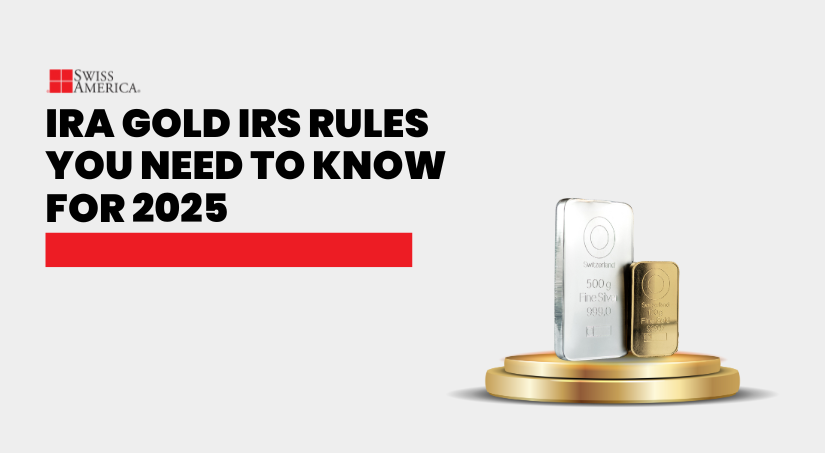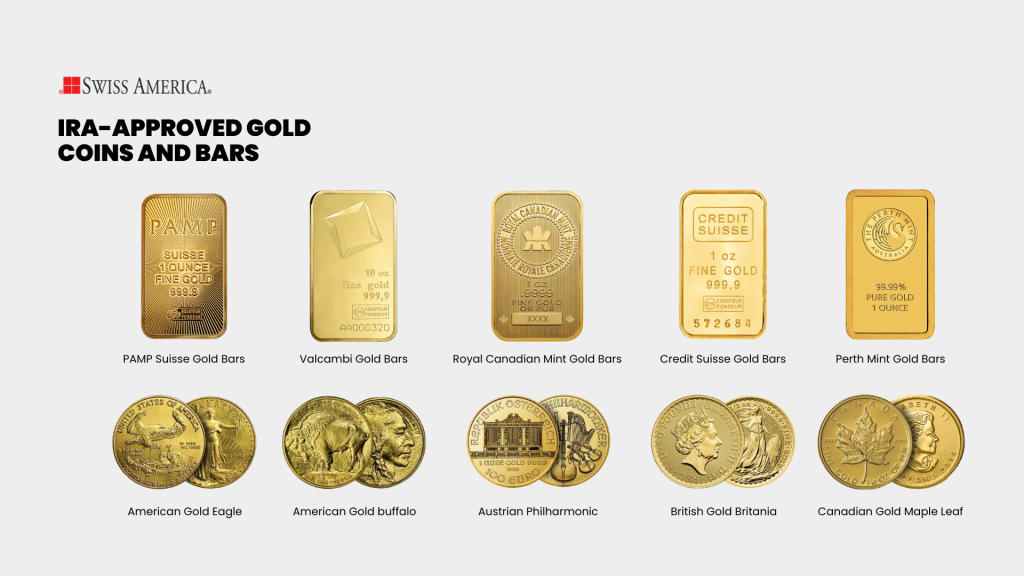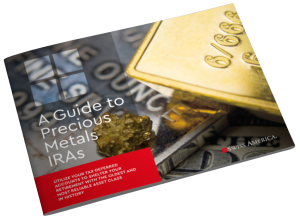
Back in July, J.P. Morgan Chase predicted gold to reach $4,000/oz by the spring of 2026. As of this writing, it’s already $3,700/oz. If you’re eyeing adding this asset to your retirement savings, what are the IRA Gold IRS rules you need to know?
This article covers all the regulations and details so you can get started with a Gold IRA to protect your wealth today.
Understanding Gold IRAs
A Gold IRA is simply a type of individual retirement account that lets you invest in physical gold and other precious metals. Unlike a traditional IRA that sticks to paper assets like mutual funds or ETFs, this account gives you the option to hold tangible assets.
For the most part, Gold IRAs follow the same rules as traditional or Roth IRAs when it comes to tax benefits, contributions, and withdrawals. The main difference is that the IRS has a few extra requirements around what kinds of metals you can buy and how you store them.
What gold and precious metals are IRS-approved?
One of the biggest questions people ask is what kind of gold or other metals you can actually buy for a Gold IRA. The IRS doesn’t allow collectibles or rare coins because it wants to make sure your retirement savings go into investment-grade assets. Here are the rules:
- Metals: The precious metals that qualify include gold, silver, platinum, and palladium.
- Form: Bars or coins.
- Manufacturer: IRS-approved precious metals come from government mints or accredited manufacturers.
- Purity: Gold must be 99.5% pure, silver 99.9% and platinum/palladium 99.95% pure.
A few examples of approved gold bullion coins and bars are the American Gold Eagle, Canadian Gold Maple Leaf, and bars from PAMP Suisse or Valcambi.

Tax benefits of a Gold IRA
So now that you know you can set up a Self-Directed IRA and use it to buy gold or other precious metals, the next question is: what are the tax benefits, and why would you want to do this? The good news is that a Gold IRA works a lot like traditional and Roth IRAs, which means you get the same key advantages. Here’s what that looks like:
Traditional IRA
This type of Self-Directed Retirement Account allows you to contribute pre-tax dollars. Then, the value of your precious metals grows tax-deferred. It also reduces your taxable income during your higher-earning years. Once you reach the retirement age of 59.5, you can withdraw funds or your metals and pay regular income tax at that time.
For 2025, you can contribute $7,000 if you are under 50 or $8,000 if you are 50 and older. Check with your financial advisor, as you might also be able to deduct your contributions.
Roth IRA
With a Roth individual retirement account, you contribute after-tax dollars. The value of your account grows tax-free, and once you reach retirement age, if you’ve held the account for at least five years, you can withdraw everything tax-free. The contribution limits are the same, though income limits determine how much you can add to this type of account.
Setting up a Gold IRA account
So, how do you go about setting up a Gold IRA account? It’s a simple process:
Step 1: Choose a precious metals IRA custodian
The first step is choosing an IRA custodian. Instead of the brokerage account you might be used to with stocks or mutual funds, the custodian manages your self-directed IRA. They handle the buying and selling of precious metals for you, take care of the IRS paperwork, and coordinate with the depository that stores your physical gold.
To pick the best option, check out our custodian list, read reviews, and talk with each company to understand their fees and policies.
Step 2: Fund your account
After opening your Gold IRA, the next step is to put money into it. You can add new funds or move money from an existing retirement plan. A lot of investors go with a rollover or transfer because it’s usually penalty-free and doesn’t count toward your yearly IRA contribution limit.
Here’s what that looks like:
- 401(k) from a previous employer: One of the most common rollovers. If you’ve left a job, you can move that account into a Gold IRA without penalty.
- Traditional IRA or Roth IRA: You can transfer both types into a self-directed Gold IRA.
- SEP and SIMPLE IRAs: If you have one of these self-employed retirement plans, you can roll it over.
- 403(b), 457(b), or Thrift Savings Plan (TSP): Any of these federal, state, and nonprofit retirement accounts also qualify.
If you’re still working and want to move a current 401(k) or workplace plan, you’ll need to check your plan’s rules. Most employers don’t allow rollovers until you either leave the job or reach retirement age.
Step 3: Choose IRS-approved precious metals
Next, you decide what precious metals you want to hold in your IRA. As we mentioned, this can include gold bullion bars, coins, or other metals like silver and platinum. Your gold dealer can also give you guidance on which options qualify for your retirement portfolio.
Step 3: Buy and store precious metals
From here, you simply tell your custodian what you want to buy. They handle the purchase and arrange storage in an IRS-approved depository. You can’t keep the gold at home because the IRS counts that as a distribution. The depository is a secure facility, and you can choose to have your metals stored commingled with others or segregated in your own space.
Pros of a Gold IRA
What are the pros if you want to hold physical gold with retirement funds? The main reasons why people like adding gold to their traditional and Roth IRAs are:
Diversification
A lot of investors want a safety net. They want to protect a portion of their retirement from the ups and downs of the stock market. Gold is a completely separate asset that doesn’t depend on the U.S. dollar or any company. Plus, it usually moves in a different direction than the market. So it’s a great asset to add as a way to balance out and protect parts of your portfolio.
Tangible asset
Many Gold IRA holders add precious metals to their retirement savings because they’re physical assets. Owning gold gives you control, direct ownership, and a store of value during economic uncertainty.
Inflation hedge
Gold coins, bars, and other precious metals can be a hedge against inflation. Since you own an actual asset, as the cost of goods and services goes up, so does the cost of your gold bars or coins. If you compare a Gold IRA versus inflation over the past 50 years in our chart below, you can see it outpaces inflation. And if you just look at the past 5 years, cumulative inflation is around 21%-25% while gold prices have increased by 93%.
Easy to sell
It can be an easy process when it’s time to sell your gold investments. First, people value gold assets all around the world, so you have a broad market to sell to. Second, the specific IRS-approved metals you buy with an IRA have value based on their metal content, so they aren’t speculative investments like collectible coins can be.
Cons of a Gold IRA
While there are a lot of great reasons people decide to use traditional or Roth Gold IRAs, there are also some drawbacks to be aware of.
No income
Gold doesn’t generate income. There’s no dividends or cash flow. The money you make when you hold physical gold is directly from price appreciation. This is why financial planners and other experts recommend that you allocate a smaller portion of your retirement portfolio in gold or other precious metals.
Account fees
Gold IRAs usually have higher account fees than traditional IRAs. That’s because the IRS requires your custodian to store your metals in an approved depository, and dealers also add premiums over the spot price. Traditional and Roth IRAs can have investment-related fees, too, but their basic account administration costs are generally lower.
Restricted options
Because of IRS regulations, you can’t just buy any metals you want. This limits some of your options, and you’ll need to work with your gold dealer to make sure whatever you’re buying is IRS-approved gold.
Risk of tax penalties
Gold IRAs can be more complex, so if you choose the wrong custodian or don’t store your metals in an IRS-approved facility, you risk tax penalties that can derail your retirement savings. The best thing is to work with a Self-Directed IRA custodian with experience in Precious Metals IRAs.
Here’s a quick summary table of the pros and cons:
| Pros | Cons |
| Diversify with assets not tied to stocks or bonds. | Gold doesn’t pay dividends or interest like other investments. |
| Gold is an inflation hedge that can rise when the dollar weakens, preserving buying power. | Higher account fees, including storage costs. |
| Provides tangible asset ownership. | Only certain IRS-approved coins and bars. |
| Gold is easy to sell. | Tax penalty risk if you don’t follow IRS rules. |
How do you sell a Gold IRA?
When you reach retirement age, you’ve got a couple of ways to take money out of your Gold IRA. There’s also a few IRS regulations to be aware of:
Selling your precious metals
Many people decide to sell their gold bars or coins. You let your custodian know what you want to sell, and your dealer gives you a buyback quote. If you accept, the proceeds into your IRA, and from there you can withdraw cash as a distribution or keep it invested.
Taking an in-kind distribution
You can also take what’s called an in-kind distribution. In this case, your custodian ships the actual gold coins or bars straight to you. With a traditional Gold IRA, the IRS counts the value of those metals as income for that year, and you’ll owe taxes on that amount.
Required minimum distributions
Traditional Gold IRAs require minimum distributions starting at age 73, while Roth Gold IRAs don’t have this requirement. A Roth can also support generational wealth because you can pass the physical gold bullion on to your heirs. If the account has been open for at least five years, they won’t owe income tax on withdrawals.
Early withdrawal penalties
It’s not a good idea to take early withdrawals from your Gold IRA before you reach retirement age because the IRS taxes it as ordinary income. On top of that, you’ll also pay a 10% penalty.
Final thoughts on a Gold IRA
If you’re thinking about adding gold to your retirement, the rules may seem complex, but they’re manageable once you know the basics. The best thing you can do is work with an experienced custodian and dealer who can help you follow all the IRS regulations. That’s where Swiss America can help.
For more than four decades, we’ve helped clients understand how gold fits into their overall savings plan and how to easily set up a Gold IRA. If you’re ready to see if this tax-advantaged account makes sense for your situation, reach out today and request our free Gold IRA kit.
IRA gold IRS rules FAQs
How is gold taxed in an IRA?
In a traditional Gold IRA, your metals grow tax-deferred, but the IRS taxes you when you take withdrawals. Those distributions count as ordinary income, and you’ll also need to start taking required minimum distributions once you turn 73.
Are gold IRAs a good idea?
A Gold IRA can make sense if you want part of your retirement in a tangible asset that doesn’t move with the stock market. It gives you diversification, protection from inflation, and peace of mind knowing some of your savings are in physical gold.
How to convert your IRA to gold without penalty?
You can convert your IRA to gold without penalty by doing a rollover into a self-directed Gold IRA. The key is to use a direct rollover, where the funds move straight from your current IRA custodian to your new Gold IRA custodian. That way, you never touch the money yourself, and the IRS won’t treat it as a withdrawal.
The information in this post is for informational purposes only and should not be considered tax or legal advice. Please consult with your own tax professionals before making any decisions or taking action based on this information.
